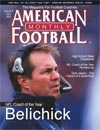AMERICAN FOOTBALL MONTHLY THE #1 RESOURCE FOR FOOTBALL COACHES
Article CategoriesAFM Magazine
|
In The Line of FireCarroll Colleges\' Pass Rush Defenseby: Mike Van Diest Head Coach, Carroll College © More from this issue A good pass rush is at the core of good pass coverage. A defensive scheme must choose between maximum rush or maximum coverage. When the Front 4 can pressure the QB on their own, this will allow the defense to commit 7 players down the field to be in position to intercept the ball. This will then allow the linebacker blitzes to become more effective as an element of surprise rather then the norm. The ultimate goal of any pass rush is to sack the passer. However, our philosophy goes beyond this. Not every snap and rush move ensures a sack, so we shave set up goals for our defensive linemen. While sacks are our main objective, we strive for constant pressure. H....The full article can only be seen by subscribers. Subscribe today!
|
|
|||||||
| HOME |
MAGAZINE |
SUBSCRIBE | ONLINE COLUMNISTS | COACHING VIDEOS |
Copyright 2025, AmericanFootballMonthly.com
All Rights Reserved





